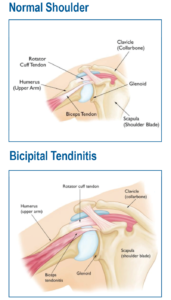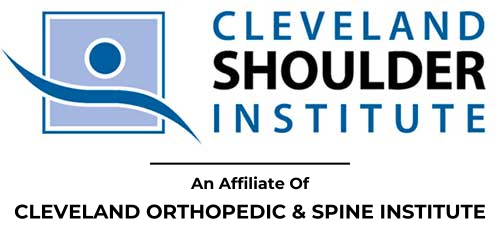What is biceps/bicipital tendinitis?
Biceps tendinitis is the inflammation of the tendon that connects your biceps muscle in the upper arm to the glenoid socket in the shoulder. Also called the long head of the biceps tendon, this cord-like structure enables your arm to bend and rotate. Biceps tendinitis is usually caused by normal wear and tear of the shoulder or overuse from a repeating the same shoulder motions over and over.
Symptoms may include pain in the front of the shoulder, swelling or weakness. The area may be tender to the touch or pain might come and go. Discomfort may become worse when you twist your arm or use it to reach over your head, and you may hear a snapping sound.
How is biceps tendinitis treated?
The first line of treatment is always to rest the shoulder and avoid activities that cause pain. You may ice the area and try over the counter drugs like ibuprofen and naproxen to ease pain and swelling. Patients with this condition typically benefit from an ultrasound guided cortisone injection which can be very effective in reducing inflammation. You may also be directed to try specific physical therapy exercises to stretch, strengthen and restore mobility to the area.
If these non-surgical options do not provide relief, and the pain interferes with your daily life, you may need to consider surgical treatment.
What is the difference between biceps tendinitis vs. biceps tear?
In most cases, tendinitis will resolve within a year. But if overuse continues to be a problem, it is possible it may turn into a tear. There are degrees of tears and many people live with minor tearing without problem.
A biceps tear is generally diagnosed based on your symptoms. While a magnetic resonance image (MRI) may be helpful to rule out other more serious shoulder problems, an MRI will not show all tears. MRIs will miss tears in the long head biceps tendon approximately 60% of the time.
Dr. Gobezie performed a study on diagnostic accuracy in detecting tears. The objective was to evaluate the accuracy of non-contrast MRI compared to arthroscopy for the diagnosis of pathology involving the intra-articular portion of the LHB tendon.
His research team concluded that “standard non-contrast MRI of the shoulder is limited in detecting partial tears and complete ruptures of the intra-articular LHB tendon.” Surgeons may encounter pathologic lesions of the LHB tendon during arthroscopy that are not visualized on the MRI.
Ultimately, this means that a surgeon may need to use arthroscopy to best determine the severity of the tear or treat the patient based on their physical symptoms.
Read more about biceps tendon injuries in athletes in this article by Dr. Gobezie in Stack, a publication for coaches and trainers.
